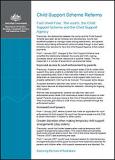Fact sheet Four: The courts, the Child Support Scheme and the Child Support Agency
Attachments

Previously, the relationship between the courts and the Child Support Scheme was seen as too complex and discretionary. Courts had insufficient powers to manage cases coming before them, and parents' choices about taking enforcement action privately through a court were limited by their decision to have the Child Support Agency (CSA) collect payments.
From 1 January 2007, changes to the Child Support Scheme have simplified the relationship between the courts and CSA, making processes easier and more responsive to parents' needs. This has happened in a number of ways which are explained below.
Improved access to court enforcement by parents
Previously, if parents receiving child support asked CSA to collect child support, they were unable to undertake their own court action to recover any outstanding debt. Even if they had other matters in court that would allow them an opportunity to recover a child support debt (such as a property settlement) CSA had to be involved. This caused some delays.If a parent wanted to take their own action in court regarding the debt, they had to assume all responsibility for collection, including for ongoing child support.
With the new arrangements, parents can take their own court enforcement action while CSA continues to collect child support on their behalf. Parents must give notice to the CSA of the enforcement action. They must also give notice to CSA of any money collected through the enforcement action.
Increased court powers
From 1 January 2007, where a parent has made an application for court enforcement of child support, the court has the same powers as the CSA to obtain information in relation to either parent.Greater discretion when making temporary child support arrangements (stay orders)
Previously, courts had limited powers when making temporary child support arrangements (stay orders). This meant debts and penalties could build up even when a court, the CSA or the Social Security Appeals Tribunal (SSAT) was examining the case.From 1 January 2007, courts have increased powers to make temporary arrangements about child support to ensure more balanced outcomes for parents and children when child support assessments are disputed. For example, stay orders can be made to suspend payments, to reduce the amount payable under the assessment or to prevent the CSA taking certain collection action such as intercepting a tax refund.
Limits on change of assessment decisions and departure orders
The CSA normally uses the child support formula to make a child support assessment. However, the formula may not provide a fair level of child support if parents or children have special circumstances. In these circumstances, the CSA can change the assessment of child support. Similarly, courts can also make orders which depart from the formula, known as a departure order.In some circumstances, the ability to make a change of assessment or departure order for a past period can provide flexibility. However, these changes can create unexpected hardship and uncertainty when they relate to assessments in the distant past.
From 1 January 2007, change of assessment decisions and departure orders are generally limited to the previous 18 months, providing a balance between flexibility and certainty for parents. If a parent wants to apply for a further period, they must apply to the court which may grant leave to apply for a change of assessment or departure order for up to seven years.
Where do I find more information?
For more information about these changes call the Family Law Courts' National Inquiry Centre on 1300 352 000.Please note this fact sheet is for general guidance only. It should not be treated as a complete or authoritative legal statement.
More details about these changes can be found in other fact sheets and on the Child Support Agency website.
More information on the Taskforce and how the reforms started is available on this website under Ministerial Taskforce on Child Support.
Last updated:
